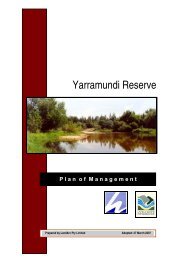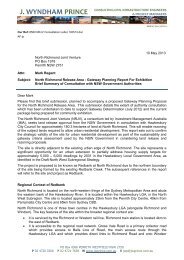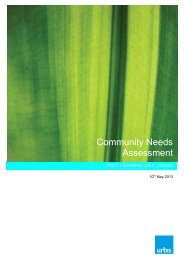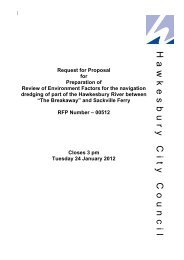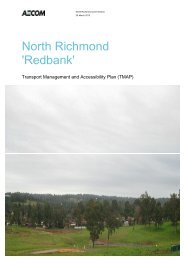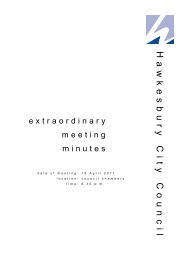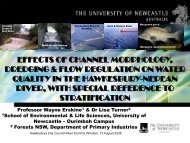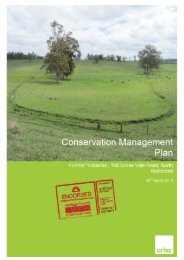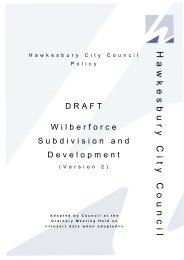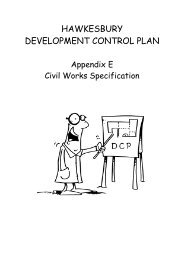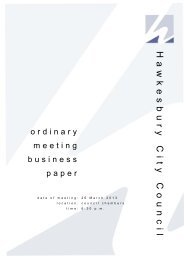Business Paper - Hawkesbury City Council
Business Paper - Hawkesbury City Council
Business Paper - Hawkesbury City Council
Create successful ePaper yourself
Turn your PDF publications into a flip-book with our unique Google optimized e-Paper software.
It is noted that the system has been sized using mean rainfall data. During dry<br />
periods, water shall be required to be tanked into the centre in a similar fashion to the<br />
current scenario.<br />
The calculation for the demand for potable water was based on the usage of the site<br />
being 3 days and two nights during the week, and 2 days and 1 night over the<br />
weekend.<br />
It is considered that the collection, storage and treatment of roof rainwater can satisfy<br />
the potable water requirements of the centre, with minimal reliance on potable water<br />
being brought to the site. In this regard, it is further considered that no adverse<br />
impact will result from the occasional truck delivery of water.<br />
Flora & Fauna<br />
A Report titled ‘Flora & Fauna Study and Ecological Assessment’, dated 6 January<br />
2011 and prepared by UBM Ecological Consultants P/L was submitted in support of<br />
the application.<br />
The Report concluded that a Species Impact Statement would be required in respect<br />
to impacts on Shale Sandstone Transition Forest and <strong>Council</strong> requested that the<br />
applicant provide one. As a result, a ‘Peer review’ and supplementary Report was<br />
submitted. These Reports titled ‘Peer review of a flora and fauna report by UBM Pty<br />
Ltd dated 6 January 2011‘, dated 2 March 2011 and ‘Flora and fauna impact<br />
assessment for the Benedict XVI Retreat Proposal 347 Grose Wold Rd, Grose Vale’<br />
dated 2 March 2011 prepared by Abel Ecology concluded respectively:<br />
“The proposal can be modified to minimize impact by:<br />
1. reducing the extent of eastern batter of the playing field where the plan shows<br />
that the batter extends into the forest;<br />
2. Provide site-specific data for both input and output from the sewerage<br />
treatment plant and provide a very clear analysis of nutrient control<br />
performance of both soil and turf;<br />
3. Redesign of bushfire APZ to indicate extent from the buildings, clearly map<br />
and specify trees for removal and retention. Once the number of trees is<br />
finalized for removal an impact can be quantified.<br />
A new impact assessment report will rely on clear data for each of the above points.<br />
Actions to ameliorate or offset the anticipated impacts may include:<br />
Weed management in the EEC;<br />
Use of EEC species (that are able to tolerate effluent) in the landscape plan;<br />
Use of felled logs as habitat enhancement in the forest; and<br />
Planting of replacement trees (including phosphorus tolerant species) in<br />
clearings beyond the APZ.<br />
“A Species Impact Statement is not recommended.<br />
A Vegetation management Plan is needed to provide the following:<br />
JRPP (Sydney West Region) <strong>Business</strong> <strong>Paper</strong> – (Item 1) (01 September 2011) – (2011SYW020) 13



